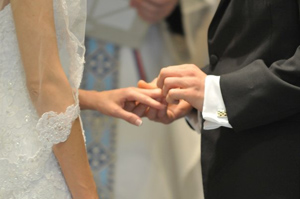 This week in most parishes of the Archdiocese of Washington, priests are being asked to review with their congregations some basic teachings on marriage and to explain why the Church opposes (so-called) “same-sex Marriage.”
This week in most parishes of the Archdiocese of Washington, priests are being asked to review with their congregations some basic teachings on marriage and to explain why the Church opposes (so-called) “same-sex Marriage.”
The Archdiocese has issued a flyer to be placed in every bulletin and you can read it here: MARRIAGE FLYER. But rather than repeat what is said there I would like to add some additional insights.
There are many good reasons to oppose same-sex “marriage,” some of them sociological, some of them psychologicalal. But, at the end of the day, the most fundamentalal reason that the Roman Catholic Church opposes a redefinition of marriage is that the Church is the steward and guardian of the truth God has given us in the Scriptures and formal Teachings of the Church. Many people want the Church to do what she simply cannot do. The Church is NOT ABLE to throw scripture and natural law overboard. We must continue to insist on what scripture teaches. We cannot nullify it. The Church has received the mandate to preach and teach God’s word whether in season or out of season. Whether popular or unpopular (2 Tim 4:2).
God established marriage in the Book of Genesis and we are taught the following essentials about marriage there:
- It was not good for Adam to be alone. He needed a “suitable partner.” (Genesis 2:18) Now notice the word “suitable” a word which the dictionary defines as “apt, proper or fitting.”
- The suitable partner for Adam is first of all human – for none of the animals proved to be suitable for Adam. (Gen 2:20)
- The suitable partner for Adam was a woman. God created Eve, a woman, not Steve, a man. (Gen 2:22)
- The suitable partner for Adam was one woman. For God did not created Eve and Ellen and Jane and Sue. Hence polygamy is not of God’s design. True enough a number of the Old Testament Patriarchs DID have more than one wife. But what the Bible reports as a fact does not necessarily imply approval. Fact is, the Bible shows how polygamy ALWAYS leads to trouble. As Biblical history unfolds, polygamy begins to disappear.
- Adam is to enter a stable relationship with his suitable partner Eve for the text says that man should leave his father and mother and cling to his wife (Gen 2:24). To cling means to adhere, to stick like glue. Hence, divorce and disunity are not part of God’s vision for marriage. Husbands and wives are to strive for unity and stability by God’s grace. The easy (no-fault) divorce of our culture is hostile to God’s plan for marriage. Couples should not seek easy ways out, they should do the work necessary to preserve union and stability in their commitment of marriage.
- Adam and Eve are told to be fruitful and multiply, to fill the earth and subdue it (Gen 1:28). Now here is the essential rationale as to why their marriage should be stable and heterosexual. In the first place marriage should be stable because that is what is best for children. Secondly, the procreation and rearing of children is an ESSENTIAL end of marriage. Some argue that gay couples can adopt. True enough, under civil law, they can adopt but they cannot procreate. Their ability to procreate is instrincally impossible. It is true that some older couples cannot have children and they are able to marry in the Church. But their infertility is due to a natural quality given by God. It is intrinsic to the feminine nature that fertility decreases with age and ultimately ceases. Homosexual union is intrinsically sterile an can never meet the requirement of being fruitful and multiplying. Adoption is not procreation.
- Jesus reiterates the teachings of Genesis in Matthew 5 and 19 (inter al.) saying that “At the beginning God made them, male and female….hence a man leaves his father and mother and clings to his wife and the two of them become one flesh.” Jesus does not say a man clings to his partner, rather his “wife.” Jesus then says with his own authority: “What God has joined together, let no one separate.” This text surely forbids divorce but one might also argue a wider interpretation wherein Jesus forbids us to tamper with what God has established. (cf Matt 19:varia)
Here then is the data of Scripture. The Church is the guardian of Scripture. We are not free to tear out pages, cross out sentences, substitute words etc. Some claim we are simply bigots, homophobes, or whatever the latest name or label they wish to attach. But in the end the Church can do nothing other than to uphold what God definitively teaches us. We are to do this in season and out of season. Right now, insofar as popular culture goes, we are “out of season,” but faithful to the Word of God anyway we speak. We can do no other.

 Usually, when you see this headline, what follows is a story about a person or group who is unhappy with the church and wants it to change–now! So, it might surprise you to learn that these are the words of Pope Benedict XVI. Needless to say,I was interested in reading more and was really pleased to see that what he is talking about is a deeper understanding of the co-responsibilityof clergy and laity for parish life and for the work of evangelization.
Usually, when you see this headline, what follows is a story about a person or group who is unhappy with the church and wants it to change–now! So, it might surprise you to learn that these are the words of Pope Benedict XVI. Needless to say,I was interested in reading more and was really pleased to see that what he is talking about is a deeper understanding of the co-responsibilityof clergy and laity for parish life and for the work of evangelization.